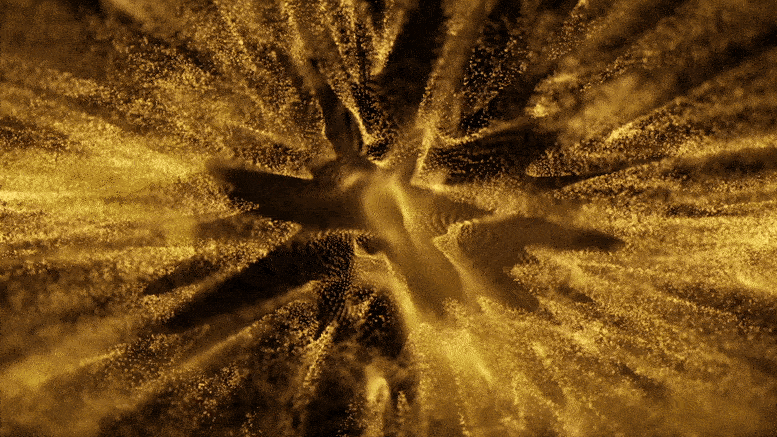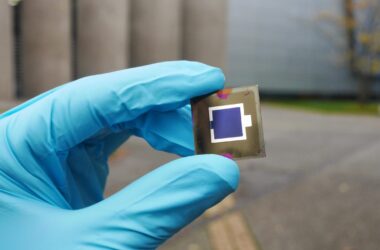
Les scientifiques ont découvert une stratégie permettant d’inverser l’aimantation dans de fines couches d’un ferromagnétique, une technique qui pourrait éventuellement conduire au développement de dispositifs de mémoire magnétique plus efficaces sur le plan énergétique. (Concept d’artiste.)
Des chercheurs de Cornell ont identifié une approche permettant de commuter l’aimantation dans les couches minces d’un ferromagnétique en tenant le matériau approprié à l’angle droit – une technique qui pourrait éventuellement conduire au développement de dispositifs de mémoire magnétique plus efficaces sur le plan énergétique.
L’article de l’équipe de recherche, “Tilted Spin Current Generated by the Collinear Antiferromagnet Ruthenium Dioxide”, a été publié aujourd’hui (5 mai 2022) dans la revue Nature Electronics. Les co-auteurs principaux de l’article sont le chercheur postdoctoral Arnab Bose et les étudiants en doctorat Nathaniel Schreiber et Rakshit Jain.
Pendant des décennies, les physiciens ont tenté de modifier l’orientation des spins des électrons dans les matériaux magnétiques en les manipulant avec des champs magnétiques. Mais les scientifiques, dont Dan Ralph, professeur de physique F.R. Newman au College of Arts and Sciences et auteur principal de l’article, ont plutôt cherché à utiliser les courants de spin transportés par les électrons, qui existent lorsque les électrons ont des spins majoritairement orientés dans une direction.
Lorsque ces courants de spin interagissent avec une fine couche magnétique, ils transfèrent leur moment angulaire et génèrent un couple suffisant pour faire basculer la magnétisation de 180 degrés (le processus de commutation de cette orientation magnétique est la façon dont on écrit les informations dans les dispositifs de mémoire magnétique).
Le groupe de Ralph s’est attaché à trouver des moyens de contrôler la direction du spin dans les courants de spin en les générant avec des matériaux antiferromagnétiques. Dans les antiferromagnétiques, tous les autres spins des électrons pointent dans la direction opposée, et il n’y a donc pas de magnétisation nette.
“Essentiellement, l’ordre antiferromagnétique peut abaisser suffisamment les symétries des échantillons pour permettre l’existence d’orientations non conventionnelles du courant de spin”, a déclaré Ralph. “Le mécanisme des antiferromagnétiques semble donner un moyen d’obtenir réellement des courants de spin assez forts, aussi”.
L’équipe avait fait des expériences avec l’antiferromagnétique dioxyde de ruthénium et mesuré la façon dont ses courants de spin faisaient basculer l’aimantation dans une fine couche d’un aimant nickel-fer alloy called Permalloy, which is a soft ferromagnet. In order to map out the different components of the torque, they measured its effects at a variety of magnetic field angles.
“We didn’t know what we were seeing at first. It was completely different from what we saw before, and it took us a lot of time to figure out what it is,” Jain said. “Also, these materials are tricky to integrate into memory devices, and our hope is to find other materials that will show similar behavior which can be integrated easily.”
The researchers eventually identified a mechanism called “momentum-dependent spin splitting” that is unique to ruthenium oxide and other antiferromagnets in the same class.
“For a long time, people assumed that in antiferromagnets spin up and spin down electrons always behave the same. This class of materials is really something new,” Ralph said. “The spin up and spin down electronic states essentially have different dependencies. Once you start applying electric fields, that immediately gives you a way of making strong spin currents because the spin up and spin down electrons react differently. So you can accelerate one of them more than the other and get a strong spin current that way.”
This mechanism had been hypothesized but never before documented. When the crystal structure in the antiferromagnet is oriented appropriately within devices, the mechanism allows the spin current to be tilted at an angle that can enable more efficient magnetic switching than other spin-orbit interactions.
Now, Ralph’s team is hoping to find ways to make antiferromagnets in which they can control the domain structure – i.e., the regions where the electrons’ magnetic moments align in the same direction – and study each domain individually, which is challenging because the domains are normally mixed.
Eventually, the researchers’ approach could lead to advances in technologies that incorporate magnetic random-access memory.
“The hope would be to make very efficient, very dense and nonvolatile magnetic memory devices that would improve upon the existing silicon memory devices,” Ralph said. “That would allow a real change in the way that memory is done in computers because you’d have something with essentially infinite endurance, very dense, very fast, and the information stays even if the power is turned off. There’s no memory that does that these days.”
Reference: “Tilted spin current generated by the collinear antiferromagnet ruthenium dioxide” by Arnab Bose, Nathaniel J. Schreiber, Rakshit Jain, Ding-Fu Shao, Hari P. Nair, Jiaxin Sun, Xiyue S. Zhang, David A. Muller, Evgeny Y. Tsymbal, Darrell G. Schlom and Daniel C. Ralph, 5 May 2022, Nature Electronics.
DOI: 10.1038/s41928-022-00744-8
Co-authors include former postdoctoral researcher Ding-Fu Shao; Hari Nair, assistant research professor of materials science and engineering; doctoral students Jiaxin Sun and Xiyue Zhang; David Muller, the Samuel B. Eckert Professor of Engineering; Evgeny Tsymbal of the University of Nebraska; and Darrell Schlom, the Herbert Fisk Johnson Professor of Industrial Chemistry.
The research was supported by the U.S. Department of Energy, the Cornell Center for Materials Research (CCMR), with funding from the National Science Foundation’s Materials Research Science and Engineering Center program, the NSF-supported Platform for the Accelerated Realization, Analysis and Discovery of Interface Materials (PARADIM), the Gordon and Betty Moore Foundation’s EPiQS Initiative, and the NSF’s Major Instrument Research program.
The devices were fabricated using the shared facilities of the Cornell NanoScale Science and Technology Facility and CCMR.


